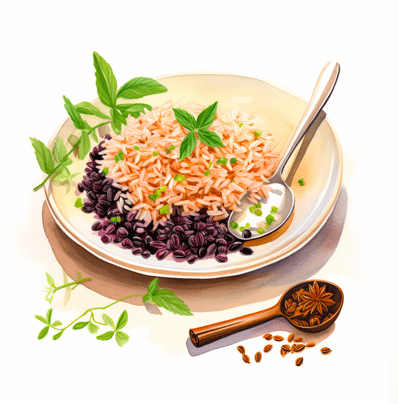
Creating Your Personal Melasma Diet Plan
Embrace a plant-based diet rich in citrus fruits, green vegetables, whole grains, legumes, and foods high in Omega-3s to naturally manage melasma. Avoid spicy foods, fast foods, and dairy, which can potentially disrupt hormonal balance and worsen skin conditions.
ABOUT ME
Be beauty. Be plant-based!
As a former Registered Nurse and avid plant-muncher, I’m in love with how simple plant-based foods make it easy to be beautiful.

Have you read?
Nourishing Your Legs: The Best Diet for Varicose Veins
Feasting for Follicles: Best Foods for an Alopecia Diet Plan
Hello, my radiant plant-based goddess! We know it’s not easy to balance a hectic lifestyle with maintaining our inner goddess glow, especially when dealing with a pesky skin disorder like melasma. This common skin condition, that can cause dark, gray, or brown patches on the skin, often feels like an unwanted guest at a party, right? Well, believe it or not, one of the secrets to managing melasma and achieving that irresistible glow lies in your diet. Yes, you read it right – a healthy melasma diet plan can have a significant impact on your skin health. Intrigued? Let’s dive in and unravel the plant-based diet’s magic!
Understanding Melasma: Causes and Symptoms
Melasma – we’ve all heard about it, but what exactly is it? Imagine your skin throwing a tiny, annoying tantrum, resulting in dark, brown or even gray patches, primarily on the face. Often, melasma is a result of a combination of sun exposure and hormonal changes, especially in pregnant women (dubbed the “mask of pregnancy”). And yes, our nemesis, UV radiation, is one of the leading causes of this skin condition.

Different skin types, particularly darker skin tones, tend to be more susceptible to skin pigmentation problems like melasma. The appearance of these discoloured patches can vary in size, shape, and the area of the body they affect. But don’t worry, my goddess, melasma is a battle we can win, especially with our secret weapon: the plant-based diet! Ready to learn more? Let’s turn the page to the next chapter of our skin health journey.
Melasma Diet Plan: Foods for UV Protection and Hormonal Balance
Our trusty allies in your very own melasma diet plan are none other than the nourishing, sun-shielding, hormone-balancing powerhouses found in a plant-based diet. Yes, the food you consume can be your enchanting elixir to manage melasma and elevate your skin health. Let’s delve into the plant-based foods that offer natural UV protection, maintain hormonal harmony, and replace those potential hormone disruptors, adding more dazzle to your divine glow.
Sunscreen Superstars: Fruits and Vegetables
Citrus fruits and green vegetables are stepping into the spotlight. Laden with Vitamin C, they act as natural UV protectors, shielding your skin from the sun’s harmful rays—a primary cause of melasma. And that’s not all. These nutrient-rich foods are also abundant in Vitamin B, a key player in hormone regulation, hence helping manage melasma effectively.

Hormonal Balance Providers: Whole Grains
When it comes to blood sugar stability and hormonal equilibrium, whole grains are your champions. Replacing refined carbs with these wholesome foods can help maintain a hormonal balance, reducing the likelihood of melasma flare-ups.
Whole grains are rich in fibre, which slows the release of sugars into the bloodstream and prevents spikes in insulin levels. Insulin is a hormone, and when its levels are consistently high, it can create a hormonal imbalance in the body. High insulin levels can disrupt other hormones too, including those involved in skin pigmentation, potentially exacerbating conditions like melasma. By helping to regulate insulin levels, whole grains contribute to overall hormonal balance.

In addition, whole grains contain essential vitamins and minerals, such as B vitamins, vitamin E, magnesium, and zinc, which are vital for various bodily functions, including hormonal production and regulation.
Protein Powerhouses: Legumes
The secret to achieving radiant skin that’s protected from UV rays and hormone-induced pigmentation lies in legumes. High in plant-based proteins, they are essential for maintaining healthy skin and hormonal balance.
Proteins, especially those from plant sources like legumes, nuts, and seeds, are made up of amino acids, the building blocks for hormones. Therefore, consuming an adequate amount of protein is essential for the body to produce hormones correctly.
Moreover, protein helps regulate the release of hormones that control appetite, such as ghrelin and leptin, promoting feelings of fullness and aiding in weight management. This is important because being overweight or obese can lead to hormonal imbalances, affecting the skin and overall health.
Proteins also help in regulating blood sugar levels, similar to whole grains, thereby ensuring insulin levels are kept in check, promoting overall hormonal balance.
Incorporating a balance of whole grains and proteins into your diet can support hormonal health, which in turn can help manage conditions influenced by hormonal imbalances, such as melasma. However, it’s essential to maintain a well-rounded diet and lifestyle, as many factors can contribute to hormonal health.
Skin Fortifiers: Healthy Fats
Don’t overlook the might of omega-3 fatty acids found in foods like chia seeds, flaxseeds, and walnuts. These healthy fats boost your skin’s resilience against UV damage and help keep your hormones in check, offering an extra layer of defence against melasma.

As we progress, remember to steer clear of potential hormone disruptors like spicy foods, fast food, and dairy products. These can disrupt your body’s hormonal balance and worsen skin conditions, including melasma. Opt instead for plant-based alternatives, such as almond milk in place of dairy or whole grain snacks instead of fast food, to maintain your radiant goddess glow.
Have you read?
The Nutty Truth: Munch More, Weigh Less!
Plant-Based Recipes for a Melasma Diet Plan
Alright, plant-based goddesses, let’s dive into the delicious part of our journey – the recipes. We’ve handpicked some quick-to-prepare, finger-licking, plant-based recipes to help you manage melasma, without having to sacrifice your taste buds.
- Citrus Salad with Dates & Pistachios at Feasting at Hom
- Protein-Packed Lentil Soup: This hearty, comforting soup packed with your choice of lentils will fill you up and nourish your skin from the inside out.
- Anti-Inflammatory Veggie Soup with Turmeric at Nutriciously
- Whole Grain Goddess Bowl: Brimming with a variety of whole grains and classic green veggies, and a generous drizzle of tasty sesame soy dressing, this bowl screams ‘melasma defense’!
- Asian Rice Bowl with Sesame Soy Dressing at Love Food Nourish

Stay tuned for more recipes that incorporate these skin-loving, melasma managing foods in your diet. Remember, these meals are not just feeding your body; they are nourishing your skin and helping it fight melasma.
Lifestyle Changes: Beyond a Melasma Diet Plan
Now that we’ve unlocked the secrets of a great melasma diet plan, let’s complement it with some crucial lifestyle changes. Think of this as arming yourself with an additional shield in your melasma battle.
First and foremost, our radiant goddesses, never underestimate the power of sun protection. Limiting sun exposure and slathering on that SPF – even when you’re just chilling at home – is critical. After all, the sun, with its UV radiation, is one of the leading culprits behind melasma.
Next up is managing those hormonal changes. Since melasma often strikes a chord with hormonal fluctuations, especially in pregnant women, it’s essential to keep these in check. And how do you do that? Regular exercise, adequate sleep, and stress management can all help balance your hormones.
Remember, these lifestyle changes are more than just melasma treatments. They’re your ticket to overall skin health and that irresistible goddess glow.

Inner Health for Outer Glow
Isn’t it amazing to think that our melasma diet plan not only influences our waistline and energy levels but also dictates the health of our skin? Embracing a plant-based diet doesn’t just manage melasma by reducing the appearance of dark, brown, and gray patches. It also nourishes our skin from within, promoting overall skin health and adding to our goddess-like radiance.
Have you read?
Radiant Skin, Naturally: 5 Plant-Based Foods for Beautiful Skin
This holistic approach to beauty – taking care of what goes inside our bodies, is just as important, if not more, than what we put on our skin. So, every time you bite into a vitamin-packed citrus fruit or savor a hearty whole grain goddess bowl, remember – you’re feeding your skin with the nutrients it needs.
And when you care for your skin from within, it shows on the outside. Your radiant skin isn’t just about looking good; it’s a reflection of your inner health and a testament to the potent combination of a plant-based diet and a skin-friendly lifestyle.
Navigating the Journey of a Melasma Diet Plan
On our journey to healthy, glowing skin, it’s important to remember that changes don’t happen overnight. Embracing a plant-based diet and making lifestyle modifications to manage melasma can be challenging, especially when you’re juggling a busy schedule.
It may sometimes feel like a balancing act of trying to incorporate green vegetables, sweet potatoes, whole grains, and avoiding dairy products and fast food. But remember, our goddess glow is a result of consistency and dedication to these changes. The radiant skin we’re after is a testament to not just the destination, but the journey itself.

It’s also key to remember that every person’s melasma journey is unique, just like our skin. What works well for one goddess may not work as well for another. It’s about listening to your body, understanding your skin, and making changes that feel right for you.
In this journey, you are not alone. As you explore and experiment with plant-based foods and lifestyle changes to manage melasma, remember there’s a community of radiant goddesses here, all navigating their unique paths to healthier skin. And remember, the struggle is part of the story. You’ve got this!
Kickstarting Your Melasma Diet Plan Today
Alright, my radiant goddesses, let’s cut to the chase and get started on our journey to a melasma-friendly diet. It might seem daunting at first, but we promise, it’s as easy as biting into a deliciously juicy orange. Here’s your guide to easily (and tastily) kickstart your plant-based, melasma-managing diet today.
- Citrus Fruits: Oranges, grapefruits, lemons, limes – all are loaded with Vitamin C, making them excellent for skin health and melasma management. They’re easy to incorporate into your diet. Grab them as a quick snack, squeeze them into a refreshing juice, or add them to your salads for a zesty twist.
- Sweet Potatoes: Nutrient-dense and incredibly delicious, sweet potatoes are a must-have in your melasma diet. Bake them, roast them, or mash them – the possibilities are endless. Plus, they’re packed with Vitamin B, which is great for skin health.
- Whole Grains: Foods like brown rice, quinoa, and oats are simple to cook and a great way to get started. They’re perfect as a base for meals and offer a comforting, hearty taste that makes your diet plan both healthful and flavorful.
- Green Leafy Vegetables: Spinach, kale, and Swiss chard are not only among the healthiest foods on the planet, but they also have a natural, subtle flavor that can easily blend into various dishes. Try them in a green smoothie for an easy and tasty start.
- Nuts and Seeds: A handful of almonds, walnuts, chia seeds, or flaxseeds can easily be sprinkled on your breakfast cereal, salads, or even enjoyed as a snack. They’re a tasty and convenient source of healthy fats, crucial for skin health.
Remember, goddesses, starting a new diet plan doesn’t mean you have to compromise on taste. With these food options, you’re all set to embark on a flavorful journey to manage melasma, one delicious bite at a time. Let’s toast to our health, skin, and the goddess glow!
Melasma In-Depth: Symptoms and Treatment
Navigating the melasma journey involves more than just a melasma diet plan and lifestyle modifications. It’s about understanding this common skin condition, its causes, symptoms, and exploring various melasma treatments available. So, let’s dive in deeper.
What Is Melasma?
Melasma, often identified as brown spots or patches on the skin, is a form of hyperpigmentation. It occurs when the skin cells responsible for pigmentation, the melanocytes, produce too much pigment in certain areas, causing noticeable, often symmetrical patches of darker skin.
Causes of Melasma
The exact underlying cause of melasma is not fully understood. However, it’s commonly linked to hormonal changes, particularly in women. Factors like pregnancy, birth control pills, and other oral contraceptives can lead to a hormonal imbalance, triggering an overproduction of melanin, the pigment responsible for our skin color. Other factors like excessive sun exposure can also play a significant role in the development of melasma.
Symptoms of Melasma
Melasma is primarily a visual condition, recognized by the appearance of dark spots on the skin. These brown spots are usually symmetrical and are commonly found on the cheeks, forehead, bridge of the nose, and upper lip. In some cases of melasma, the patches might even appear on the neck and forearms. While melasma doesn’t pose a physical health risk, it can affect a person’s quality of life, impacting self-esteem and overall wellbeing.
Melasma Treatment
Treating melasma usually involves addressing the excess pigmentation to restore the skin to a more even tone. It often includes topical medications and facial treatments. Here are a few options:
- Topical Medications: Topical creams containing ingredients like azelaic acid, kojic acid, or glycolic acid can help lighten the melasma spots. These are often first-line treatment options and can be available as over-the-counter medication or prescribed by a dermatologist.
- Tranexamic Acid: Tranexamic acid, usually taken orally, has shown promise in the treatment of melasma. It works by slowing down the melanin production, leading to lighter skin patches over time.
- Medical Procedures: In some cases, procedures like chemical peels, microdermabrasion, or laser treatments might be recommended. These should always be done under professional supervision.
It’s crucial to discuss your medical history and lifestyle with a healthcare provider before starting a melasma treatment plan. Certain treatments can have adverse effects, like hormonal changes leading to weight gain, so it’s essential to understand these implications.
Remember, achieving healthy skin and managing melasma with a melasma diet plant is a journey. It’s about finding the right balance between dietary changes, lifestyle modifications, and appropriate treatment options. By understanding melasma better, we can confidently navigate this journey and reclaim our goddess glow!
References
Lawson CN, Hollinger J, Sethi S, et al. Updates in the understanding and treatments of skin & hair disorders in women of color. Int J Womens Dermatol. 2015;1(2):59-75. Published 2015 May 27. doi:10.1016/j.ijwd.2015.04.002